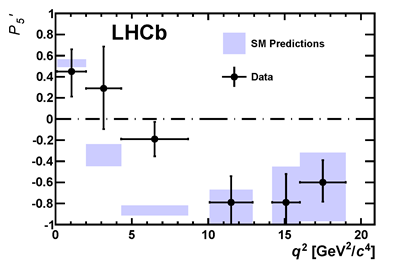The LHCb Collaboration has just published the results of a new analysis of the B0→K*0μ+μ– decay, with K*0→K+π–. These results were presented three weeks ago at the European Physical Society Conference on High Energy Physics, EPSHEP, Stockholm, Sweden, and triggered very interesting discussions. The analysis of the B0→K*μμ decay is considered as a very promising channel to search for new physics effects, see the 14 June 2013 news for an introduction. A contribution from new physics particles could modify the angular distributions of the decay products. LHCb physicists have studied different variables related to these angular distributions as functions of the μ+μ– invariant mass squared. In previously published results, no significant deviation from the Standard Model prediction has been found, see the 13 March 2012 news. In order to increase sensitivity to new physics effects LHCb physicists started to analyse additional observables (the so called Pi‘ observables) which are considered theoretically clean. This means that they are less sensitive than other observables to some theoretical parameters that are not precisely known (form-factors for experts). Four such observables, labelled P4‘, P5‘, P6‘ and P8‘, have been studied.
The image shows the distribution of the P5‘ observable as a function of the μ+μ– invariant mass squared q2. The black data points are compared with the Standard Model prediction. A 3.7σ deviation of data above the prediction is observed for the third bin corresponding to q2 between 4.3 and 8.68 GeV2/c4. Taking into account that this deviation is observed in one out of 24 bins investigated in this work (the so-called look-elsewhere effect), the significance of the deviation becomes 2.8σ.
.
click the image for higher resolution
These new results are of great interest to theorists, who are combining results from several measurements to search for effects of physics beyond the Standard Model. According to Joaquim Matias from Universitat Autonoma de Barcelona and colleagues the deviation in P5‘ and small discrepancies in the other angular observables for this decay, follow a pattern. In a recent paper the authors claim that a global analysis of the LHCb data, together with previous measurements, show a deviation of 4.5σ with respect to Standard Model expectations, which can be explained with the same mechanism (reduced Wilson coefficient C9 for experts). This demands further investigation, in particular to re-evaluate all the sources of theoretical uncertainty, and to understand the effects of correlations between the experimental measurements. A deep interplay between experimental and theoretical analyses will be essential to confirm or refute the pattern of new physics suggested by the B0→K*μ+μ– anomaly.
The results presented so far are based on 1fb-1 of data recorded from pp collisions at 7 TeV in 2011. Particle physicists are impatiently waiting for result of analysis of additional 2fb-1 of data taken at 8 TeV in 2012.
Read more in the LHCb presentation in Stockholm. in the LHCb paper and in the CERN Courier article.

